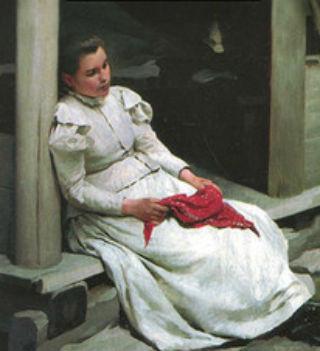Why is the image of Katerina still causing literary controversy? Ostrovsky's "Thunderstorm" - a play in five acts - is understood differently by even brilliant critics Dobrolyubov and Pisarev. All literary scholars agree on one thing: the musty life of the Russian philistine backwoods of the 19th century (the fictional city of Kalinov) is unconditionally masterfully shown. Stagnation reigned in Russia. Serfdom, like fetters, restrained the development of a vast country. Alexander Nikolayevich Ostrovsky with his work managed to stir up the Russian intelligentsia, showing in it a tear-emotional image with a tragic fate.
Where did the image of Katerina come from?
The main character is a deeply folk type of a young woman with a creative attitude, deep spirituality, elemental strong emotions.
She is endowed with passions that are not constrained by reason. Obviously, Ostrovsky’s play The Storm is endowed with autobiographical features. The image of Katerina, who decided on an extramarital affair, was created by Ostrovsky, apparently descending from the prototype - actress Kositskaya Lyubov Pavlovna. Both the actress and the playwright had their own families, but their mutual relations were ambiguous. Of course, the world of relations between these two creative people was rich. Obviously, there was a certain conflict in it between family relations and passionate love “on the side”. As his refraction in the tragic fate of a Russian woman, the drama Ostrovsky's “Thunderstorm” appeared. The image of Katerina in her contrasts with any image from her environment, and with the whole environment at the same time.
The main character of "Thunderstorm" and her entourage
Katerina's social status is a merchant daughter-in-law. The girl married Tikhon Kabanov. With her husband, they live in a rich house near the mother-in-law of Martha Ignatievna. Tikhon has an unmarried sister, Barbara. She also lives in the house. The main "family ideologist" is the mother-in-law. She is contrasted with the image of Katerina. Ostrovsky's “Thunderstorm”, as the name of the work, according to Dobrolyubov, reflects the conflict between tyranny and mute. But tyranny really flourishes in the Kabanovs' house: Marfa Ignatyevna is a pragmatic, authoritarian woman. Her morality is invincible, prudish. She is not inclined to reconcile the house style with the desires of her immediate family. What for? Kabanikha (such is her nickname) knows, "as it should be." And the whole house obeys her. But the daughter-in-law instinctively disagrees with spirituality and mercantilism.
The image of Katerina in the vision of critics

According to the literary critic Pisarev, the image of Katerina does not differ in either a solid character or a clear mind. Ostrovsky's “Thunderstorm” (as the name of the drama) simultaneously reveals another conflict - between the emotional nature of the heroine and the outside world. The world is certainly not harmonious. But Katerina is fundamentally deprived by the author of the main instrument of social coexistence - Christian humility. According to Pisarev, from childhood she has the ability to make an unreasonable protest act. According to the vision of Dobrolyubov, she strives for "the vastness of life", she is inherent in the "strength of character." The polemic of literary scholars is obvious. But it is difficult to disagree with Pisarev: only emotions and passions make up the image of Katerina. Ostrovsky's “Thunderstorm” tells that a young woman just needs to exchange passionate views to have a feeling for Boris (the educated nephew of the wealthy merchant Savel Prokofievich Dikogo). Without really understanding what kind of person this is, the girl rushes into her feeling like a whirlpool, with her head. Impulsive and absurd death of a young woman. "Extreme" Dobrolyubov saw its reason in the reluctance of the heroine to live in a lying hypocritical world. More reasonable Pisarev followed, like a real psychologist, the logical chain of her thoughts, which led to the fateful step. It is characteristic that initially Katerina did not even think about suicide. On a date, she found out that beloved Boris was going to Siberia and that he did not take her with him. Katerina needs to return home, but for some reason she decides what will be better “in the grave”. Then an association comes to mind for a young woman - wildflowers on a grave. Forgetting that this is a sin, touched by an imaginary flower kingdom, clasped hands with a cross, she jumps into the Volga.
conclusions
The image of Katerina is certainly bright. Ostrovsky was able to reliably portray the originality of her thinking, openness of feelings. There is nothing artificial, far-fetched in it. She is like a natural element: feelings and emotions determine the course of her life. Yes, she stands out among the middle class. However, is it possible to figuratively call it a "ray of light" in a kindly way? Indeed, besides the openness of feelings, “light” is also associated with reason, with service, with kindness. The life of a bright man is not a flash in the night, but an illumination with the even soft light of all those around him. In this understanding, the “ray of light" is the famous literary images: Maria Bolkonskaya with her peerless radiant eyes, Lady Melanie ("Gone with the Wind").